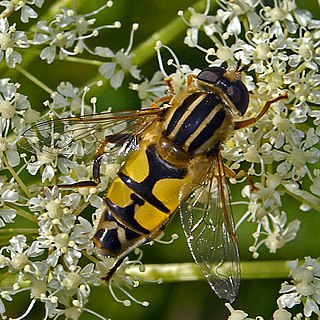
The Agromyzidae are a family of flies, commonly referred to as the leaf-miner flies for the feeding habits of their larvae, most of which are leaf miners on various plants. It includes roughly 2,500 species, they are small, some with wing length of 1 mm. The maximum size is 6.5 mm. Most species are in the range of 2 to 3 mm.

Helophilus pendulus is a European hoverfly. Its scientific name means "Dangling marsh-lover". It is a very common species in Britain, where it is the commonest Helophilus species. It is found throughout Europe from the Mediterranean to Scandinavia, westward to the Faroe Islands and Iceland, and through eastward through Russia from the Kola Peninsula south to Crimea and across Siberia to the Pacific Ocean.

Chrysotoxum bicinctum is a species of hoverfly.

Spilomyia sayi, the Four-lined Hornet Fly, is a fairly common species of syrphid fly. This species is found from western Canada to northeastern North America. Hoverflies get their names from the ability to remain nearly motionless while in flight. The adults are also known as flower flies for they are commonly found around and on flowers, from which they get both energy-giving nectar and protein-rich pollen. The larvae are known as the short-tailed larvae, suited for moist areas such as rot holes of trees. It is a wasp mimic.

Helophilus trivittatus is a species of Palearctic hoverfly.

The genus Chrysotoxum consists of large, wasp-mimicking species. The adults are distinguished by very long antennae, oval abdomen with yellow stripes, and yellow patterns on the thoracic pleurae . The species of Chrysotoxum are chiefly Holarctic in distribution. . The species in this genus, are mostly very uniform in structure and colour and are separated with difficulty. Larvae are specialized in preying upon root aphids associated with ant nests.

Conops quadrifasciatus, the yellow-banded conops, is a species of fly from the genus Conops in the family Conopidae.

Platycheirus granditarsus, the Hornhand Sedgesitter, is a species of hoverfly. It is found in many parts of Britain North America and Europe. Typical habitat includes marshy meadows and ditches, where it can be found between May and October, though it is at its commonest between July and September. The most distinctive feature of this fly is the red-orange abdomen most easily seen as it takes off or alights.

Herina paludum is a species of picture-winged fly in the genus Herina of the family Ulidiidae.

Oxycera pardalina, the hill soldier, is a European species of soldier fly.

Didea alneti is a Holarctic species of hoverfly.

Cylindromyia brassicaria is a species of fly in the family Tachinidae.

The Cryptochetidae are a small family of tiny flies. Some twenty to thirty species are known. Generally they are metallic blue black, stoutly built, with the head broad and high and with clear wings. Like other species in the superfamily Lonchaeoidea, the Cryptochetidae have antennae with a cleft in the second segment. Unlike practically all Schizophora however, they lack an arista, or if they do have one, it is too small to distinguish with any confidence. The family name refers to this unusual distinction; "Cryptochetidae" literally means "those with hidden bristles". The adult flies also are unusual among insects in that they have only a single pair of abdominal spiracles — this is not a serious physiological challenge in such small insects.
Chrysotoxum flavifrons, the Blackshield Meadow Fly, is a species of North American hoverfly. They are wasp mimics.
Chrysotoxum perplexum is a North American species of syrphid fly in the family Syrphidae.The adults are strong mimics of wasps. Larvae of this genera, when known, are aphid predators.
Neoascia geniculata is a Palearctic species of hoverfly.
Pylaemenes konkakinhensis is a species of stick insects native in Vietnam. The species is so far only known from a single female.

Hemipenthes maura is a species of bee fly belonging to the family Bombyliidae.

Chrysotoxum baphyrum is a species of holarctic hoverfly. The adults are strong mimics of wasps. Larvae of this genera, when known, are aphid predators.

Chrysotoxum fasciolatum is a species of holarctic hoverfly. The adults are strong mimics of wasps. Larvae of this genera, when known, are aphid predators.
















